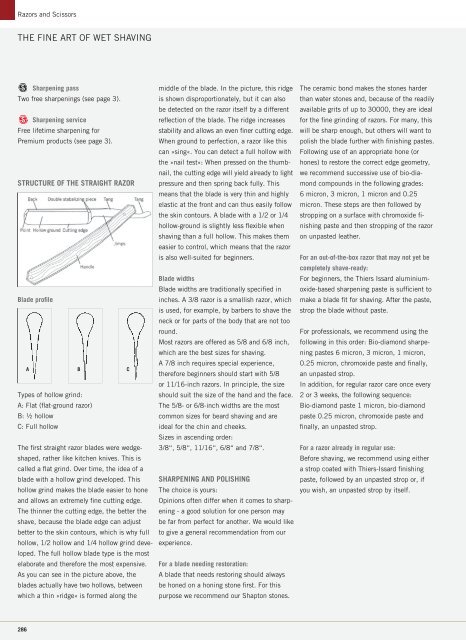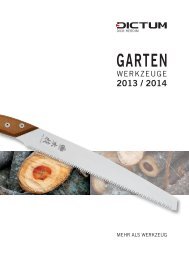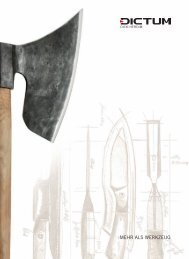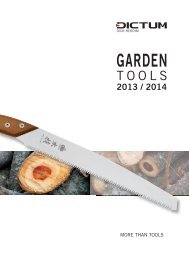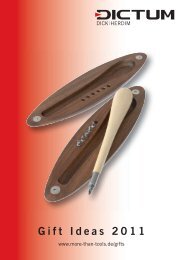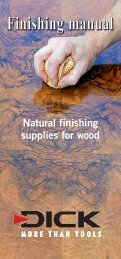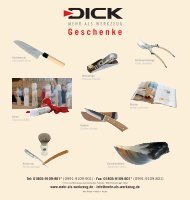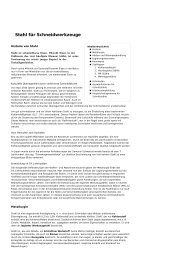Download latest Tool Catalogue as PDF - DICTUM GmbH
Download latest Tool Catalogue as PDF - DICTUM GmbH
Download latest Tool Catalogue as PDF - DICTUM GmbH
Create successful ePaper yourself
Turn your PDF publications into a flip-book with our unique Google optimized e-Paper software.
Razors and ScissorsTHE FINE ART OF WET SHAVINGSharpening p<strong>as</strong>sTwo free sharpenings (see page 3).Sharpening serviceFree lifetime sharpening forPremium products (see page 3).StrUctUre Of the Straight razOrBlade profilea B cTypes of hollow grind:A: Flat (flat-ground razor)B: ½ hollowC: Full hollowThe first straight razor blades were wedgeshaped,rather like kitchen knives. This iscalled a flat grind. Over time, the idea of ablade with a hollow grind developed. Thishollow grind makes the blade e<strong>as</strong>ier to honeand allows an extremely fine cutting edge.The thinner the cutting edge, the better theshave, because the blade edge can adjustbetter to the skin contours, which is why fullhollow, 1/2 hollow and 1/4 hollow grind developed.The full hollow blade type is the mostelaborate and therefore the most expensive.As you can see in the picture above, theblades actually have two hollows, betweenwhich a thin »ridge« is formed along themiddle of the blade. In the picture, this ridgeis shown disproportionately, but it can alsobe detected on the razor itself by a differentreflection of the blade. The ridge incre<strong>as</strong>esstability and allows an even finer cutting edge.When ground to perfection, a razor like thiscan »sing«. You can detect a full hollow withthe »nail test«: When pressed on the thumbnail,the cutting edge will yield already to lightpressure and then spring back fully. Thismeans that the blade is very thin and highlyel<strong>as</strong>tic at the front and can thus e<strong>as</strong>ily followthe skin contours. A blade with a 1/2 or 1/4hollow-ground is slightly less flexible whenshaving than a full hollow. This makes theme<strong>as</strong>ier to control, which means that the razoris also well-suited for beginners.Blade widthsBlade widths are traditionally specified ininches. A 3/8 razor is a smallish razor, whichis used, for example, by barbers to shave theneck or for parts of the body that are not tooround.Most razors are offered <strong>as</strong> 5/8 and 6/8 inch,which are the best sizes for shaving.A 7/8 inch requires special experience,therefore beginners should start with 5/8or 11/16-inch razors. In principle, the sizeshould suit the size of the hand and the face.The 5/8- or 6/8-inch widths are the mostcommon sizes for beard shaving and areideal for the chin and cheeks.Sizes in <strong>as</strong>cending order:3/8“, 5/8“, 11/16“, 6/8“ and 7/8“.Sharpening and pOliShingThe choice is yours:Opinions often differ when it comes to sharpening- a good solution for one person maybe far from perfect for another. We would liketo give a general recommendation from ourexperience.for a blade needing restoration:A blade that needs restoring should alwaysbe honed on a honing stone first. For thispurpose we recommend our Shapton stones.The ceramic bond makes the stones harderthan water stones and, because of the readilyavailable grits of up to 30000, they are idealfor the fine grinding of razors. For many, thiswill be sharp enough, but others will want topolish the blade further with finishing p<strong>as</strong>tes.Following use of an appropriate hone (orhones) to restore the correct edge geometry,we recommend successive use of bio-diamondcompounds in the following grades:6 micron, 3 micron, 1 micron and 0.25micron. These steps are then followed bystropping on a surface with chromoxide finishingp<strong>as</strong>te and then stropping of the razoron unp<strong>as</strong>ted leather.for an out-of-the-box razor that may not yet becompletely shave-ready:For beginners, the Thiers Issard aluminiumoxide-b<strong>as</strong>edsharpening p<strong>as</strong>te is sufficient tomake a blade fit for shaving. After the p<strong>as</strong>te,strop the blade without p<strong>as</strong>te.For professionals, we recommend using thefollowing in this order: Bio-diamond sharpeningp<strong>as</strong>tes 6 micron, 3 micron, 1 micron,0.25 micron, chromoxide p<strong>as</strong>te and finally,an unp<strong>as</strong>ted strop.In addition, for regular razor care once every2 or 3 weeks, the following sequence:Bio-diamond p<strong>as</strong>te 1 micron, bio-diamondp<strong>as</strong>te 0.25 micron, chromoxide p<strong>as</strong>te andfinally, an unp<strong>as</strong>ted strop.for a razor already in regular use:Before shaving, we recommend using eithera strop coated with Thiers-Issard finishingp<strong>as</strong>te, followed by an unp<strong>as</strong>ted strop or, ifyou wish, an unp<strong>as</strong>ted strop by itself.286


